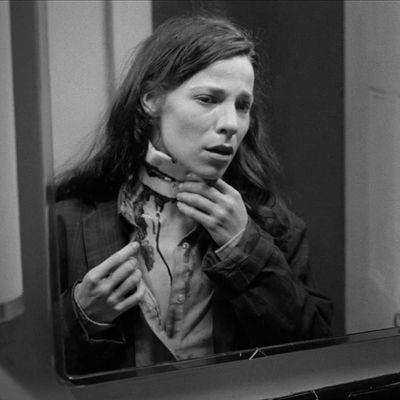
With apologies to Transylvania and Sunnydale, the ideal place to be a vampire was New York City in the mid-’90s. The only proof you need is a cluster of indie movies that came out so close together in 1994 and 1995 that they’re basically an example of multiple discovery. Michael Almereyda’s Nadja, Abel Ferrara’s The Addiction, and Larry Fessenden’s Habit operated under the common thesis that if bloodsuckers stalked the streets of the city, they’d blend seamlessly into the crowd, because resident scenesters like wearing dark clothes and being dramatic just as much as any supernatural figure. Vampires may be larger than life, but in these movies — two of them shot in black-and-white; all of them small, scrappy productions — they’re made to look small. They turn up in mundane places like a party, or at a bar, or on a walk — just a few more eccentrics looking to connect. It’s the city that ends up looking big, a bustling but precarious place where someone’s disappearance could go unremarked upon for days, ascribed to a bender, or a hot hooking, or a bout of depression.
Vampirism, in this trio of movies, looks like a pallid, pointy brunette who likes to wander the streets of Manhattan while wearing black. Downtown hipsterdom intersects with the supernatural in wry ways. Kathleen Conklin, the grad student played by Lili Taylor in The Addiction, starts dressing in monochrome and wearing sunglasses indoors after getting bitten by a stranger one night. She’s going through a radical transformation, but from a distance, it just looks like a pretentious phase. “We’re all called in for the debt. Most of us go for plastic surgery to hide the blemishes — but you can’t cut where the disease originates,” she rants to her bewildered colleague Jean (Edie Falco). Anna (Meredith Snaider), the waif with a pixie haircut that Sam (Larry Fessenden) begins a rebound relationship with in Habit, justifies her refusal to tell him about her job by saying, “It doesn’t really have anything to do with who I am.” It’d be a reasonable rejection of careerism if she were willing to share anything else about herself — like whether, as Sam starts to suspect, she’s draining the life out of him.
Even the title character in Almereyda’s not-quite-comedic saga, who smokes a cigarette while sumptuously making her way along the sidewalk to Portishead in a hooded cape, manages to sound like an apologetic European heiress out getting her kicks in the city when she talks about her background. “Family money from Romania,” she admits to a man she’s struck up a flirtation with in a bar. “It comes from the suffering and exploitation of the poor — the peasants, the workers.” Of course, the cruel father she mentions happens to be Count Dracula, and in the next scene she’s sinking her teeth into her conversation partner’s throat. If these movies were first received as subversive takes on a classic horror figure, in 2021 they feel more like prescient examples of the ways in which vampire mythos can accommodate boredom, awkwardness, and loneliness.
Vampirism looks grubby and desperate in these movies, especially when it’s used as a window into addiction. Sam’s physical decline over the course of Habit may come courtesy of Anna drinking his blood whenever she finds her way into his bed, but it may also be due the steady drinking that’s such a fundamental part of his life, it’s not until the final act of the movie that someone actually mentions it out loud. The metaphor’s even more explicit in The Addiction, in which Kathleen begins her dark journey by injecting blood with a syringe before giving in and going direct to the source. When she encounters an older vamp, played by Christopher Walken, he chides her about her lack of control, telling her, “The point is to blend in, not to stand out like a sore thumb. My habit is controlled by my will,” before feeding on her himself. She staggers out onto the sidewalk, begging for help, but when a stranger comes to her aid, she goes right for his carotid.
The Addiction, Habit, and Nadja at the start of the Giuliani years, when the city was emerging from the crack epidemic and when AIDS-related deaths were continuing to rise. (“The AIDS virus couldn’t manifest itself so quickly, if you’re curious about that,” a doctor tells Kathleen when the bite wound she’s sustained starts leading her to vomit blood.) Drug and alcohol dependency may be the most obvious onscreen parallels, but they’re not the only ones. These movies offer a sense of the city as shot through with potential as much as with danger, a place where you never know what a stranger might offer. Kathleen’s shown nervously trying to navigate a sidewalk packed with cat-callers and idlers at the start of The Addiction, though when she does get attacked one night, it’s by a well-dressed white woman named Casanova, played by Annabella Sciorra, who grabs her right off the street, with no one noticing or commenting.
Sciorra — turned directly at the camera in this scene, with the light through a grate dappling her face — is equal parts alluring and threatening. She makes no attempt to seduce, instead sneering at Kathleen, “Look at me and tell me to go away,” as though what’s going to happen is actually her fault for not putting on a tough enough front. That’s what makes this mini moment in vampire movies so memorable, the way they find a strange sort of romance in the city’s vast indifference. It’s the kind of place that can get too much for even an immortal. Toward the end of Nadja, its vampiress heroine ends up beating a retreat to her ancestral castle after tangling with some fumbling contemporary Van Helsings. It’s not the threat they represent so much as New York itself that seems to do her in. “Too many choices, too many possibilities,” she sighs.


